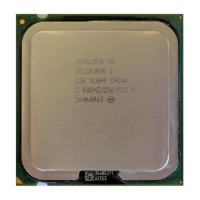Balanced Technology Extended (BTX) System Thermal Considerations
R
Thermal/Mechanical Design Guide 91
Appendix F Balanced Technology
Extended (BTX) System
Thermal Considerations
There are anticipated system operating conditions in which the processor power may be low but
other system component powers may be high. If the only Fan Speed Control (FSC) circuit input
for the Thermal Module Assembly (TMA) fan is from the processor diode, then the fan speed and
system airflow is likely to be too low in this operating state. Therefore, it is recommended that a
second FSC circuit input be acquired from an ambient temperature monitor location within the
system.
The location of the System Monitor thermal sensor is best determined through extensive system-
level numerical thermal modeling or prototype thermal testing. In either case, the temperature of
critical components or the air temperature near critical components should be assessed for a range
of system external temperatures, component powers, and fan speed operating conditions. The
temperature at the selected location for the System Monitor Point should be well correlated to the
temperatures at or near critical components. For instance, it may be useful to monitor the
temperature near the PSU airflow inlet, near the graphics add-in card, or near memory.
The final system integrator is typically responsible for ensuring compliance with the component
temperature specifications at all operating conditions and, therefore, should be responsible for
specifying the System Monitor thermal sensor location. However, it is not always possible for a
board supplier – especially a channel board supplier – to know the system into which a board will
be installed. It is, therefore, important for BTX board suppliers to select a System Monitor
thermal sensor location that will function properly in most systems.
A BTX system should be designed such that the TMA exhaust is the primary airflow stream that
cools the rest of the system. The airflow passes through the chipset heatsink and its temperature
will rise as the memory controller chipset power increases. Since chipset power will increase
when other subsystems (e.g., memory, graphics) are active, a System Monitor thermal sensor
located in the exhaust airflow from the chipset heatsink is a reasonable location.
It is likely that a thermal sensor that is not mounted above the board and in the chipset exhaust
airflow will reflect board temperature and not ambient temperature. It is therefore recommended
that the Thermal sensor be elevated above the board.
The thermal sensor location and elevation are reflected in the Flotherm thermal model airflow
illustrations (see
Figure 43 and Figure 44).The Intel
®
Boxed Boards in BTX form factor have
implemented a System Monitor thermal sensor. The following thermal sensor or its equivalent can
be used for this function:
Part Number: C83274-002
BizLink USA Technology, Inc.
44911 Industrial Drive
Fremont, CA 94538 USA
(510)252-0786 phone
(510)252-1178 fax
sales@bizlinktech.com
Part Number: 68801-0170
Molex Incorporated
2222 Wellington Ct.
Lisle, IL 60532
1-800-78MOLEX phone
1-630-969-1352 fax
amerinfo@molex.com

